

Compact Muon Solenoid
LHC, CERN
| CMS-HIG-21-003 ; CERN-EP-2022-095 | ||
| Search for the exotic decay of the Higgs boson into two light pseudoscalars with four photons in the final state in proton-proton collisions at $\sqrt{s} = $ 13 TeV | ||
| CMS Collaboration | ||
| 2 August 2022 | ||
| JHEP 07 (2023) 148 | ||
| Abstract: A search for the exotic decay of the Higgs boson to a pair of light pseudoscalars, each of which subsequently decays into a pair of photons, is presented. The search uses data from proton-proton collisions at $\sqrt{s} = $ 13 TeV recorded with the CMS detector at the LHC that corresponds to an integrated luminosity of 132 fb$^{-1}$. The analysis probes pseudoscalar bosons with masses in the range 15-62 GeV, coming from the Higgs boson decay, which leads to four well-isolated photons in the final state. No significant deviation from the background-only hypothesis is observed. Upper limits are set on the product of the Higgs boson production cross section and branching fraction into four photons. The observed (expected) limits range from 0.80 (1.00) fb for a pseudoscalar boson mass of 15 GeV to 0.26 (0.24) fb for a mass of 62 GeV at 95% confidence level. | ||
| Links: e-print arXiv:2208.01469 [hep-ex] (PDF) ; CDS record ; inSPIRE record ; HepData record ; CADI line (restricted) ; | ||
| Figures | |
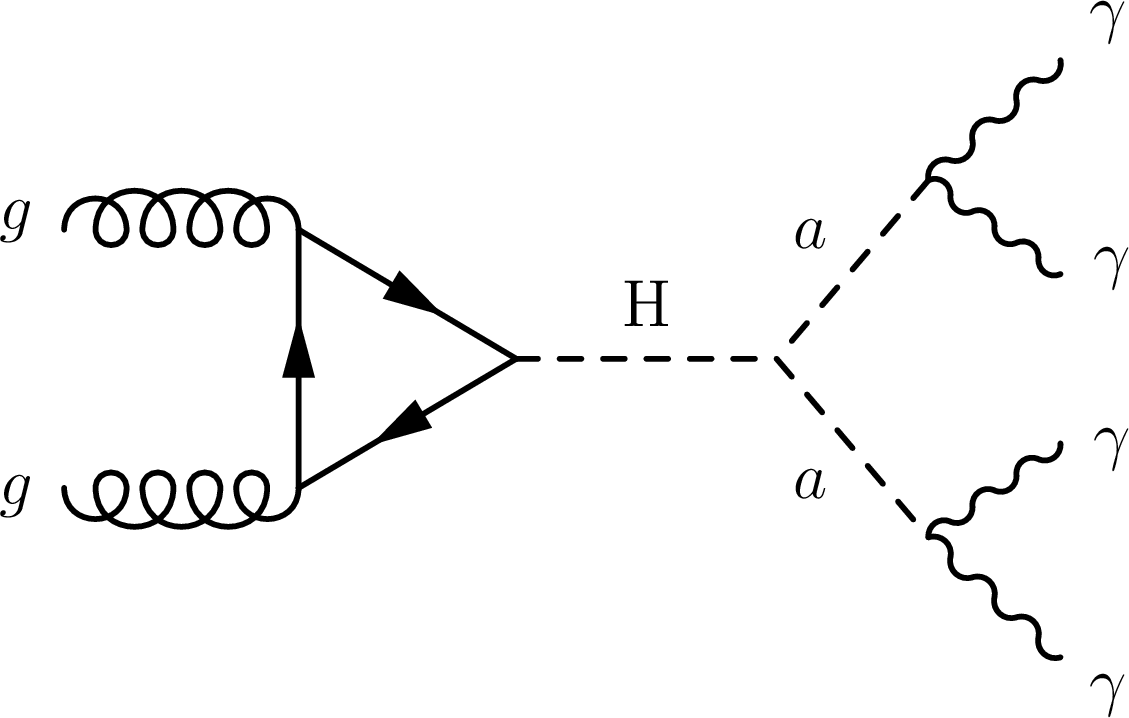
png pdf |
Figure 1:
Feynman diagram for a BSM decay of the Higgs boson into a pair of light pseudoscalar bosons that subsequently decay into photons. |

png pdf |
Figure 2:
Distributions of the four most highly ranked discriminating variables: the difference between the invariant masses of the pseudoscalar bosons and the ${m_{a,\text {hyp}}}$ parameter, divided by the invariant mass of the four-photon system (upper left), with off-zero signal peaks from photon pairing mismatches; the difference between the invariant masses of the pseudoscalar bosons (upper right); the photon identification BDT score of the third leading, $\gamma _{3}$ (lower left) and the fourth leading, $\gamma _{4}$ (lower right) photons. The events shown are selected from the ${m_{\gamma \gamma \gamma \gamma}}$ sidebands (110 $< {m_{\gamma \gamma \gamma \gamma}} < $ 115 GeV or 135 $ < {m_{\gamma \gamma \gamma \gamma}} < $ 180 GeV) for event mixing and data after fulfilling the selection criteria described in Section 4, while the signals are scaled with a cross-section of 1 pb. |

png pdf |
Figure 2-a:
Distribution of the difference between the invariant masses of the pseudoscalar bosons. The events shown are selected from the ${m_{\gamma \gamma \gamma \gamma}}$ sidebands (110 $< {m_{\gamma \gamma \gamma \gamma}} < $ 115 GeV or 135 $ < {m_{\gamma \gamma \gamma \gamma}} < $ 180 GeV) for event mixing and data after fulfilling the selection criteria described in Section 4, while the signals are scaled with a cross-section of 1 pb. |
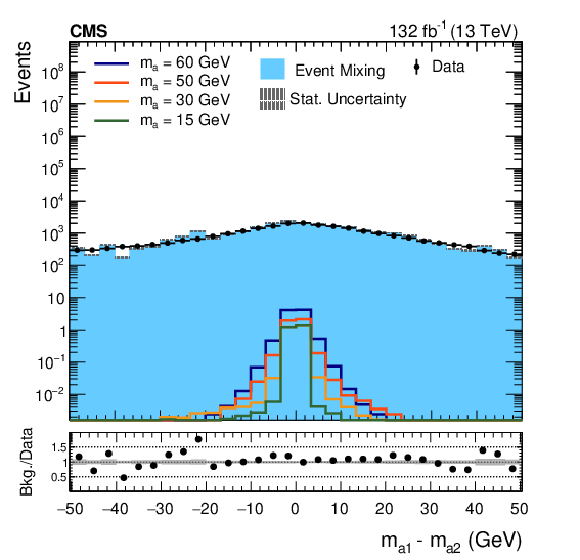
png pdf |
Figure 2-b:
Distributions of the four most highly ranked discriminating variables: the difference between the invariant masses of the pseudoscalar bosons and the ${m_{a,\text {hyp}}}$ parameter, divided by the invariant mass of the four-photon system (upper left), with off-zero signal peaks from photon pairing mismatches; the difference between the invariant masses of the pseudoscalar bosons (upper right); the photon identification BDT score of the third leading, $\gamma _{3}$ (lower left) and the fourth leading, $\gamma _{4}$ (lower right) photons. The events shown are selected from the ${m_{\gamma \gamma \gamma \gamma}}$ sidebands (110 $< {m_{\gamma \gamma \gamma \gamma}} < $ 115 GeV or 135 $ < {m_{\gamma \gamma \gamma \gamma}} < $ 180 GeV) for event mixing and data after fulfilling the selection criteria described in Section 4, while the signals are scaled with a cross-section of 1 pb. |
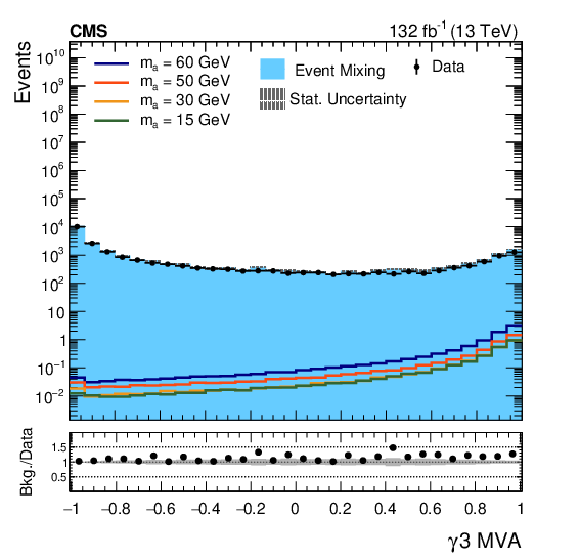
png pdf |
Figure 2-c:
Distribution of the photon identification BDT score of the third leading photon, $\gamma _{3}$. The events shown are selected from the ${m_{\gamma \gamma \gamma \gamma}}$ sidebands (110 $< {m_{\gamma \gamma \gamma \gamma}} < $ 115 GeV or 135 $ < {m_{\gamma \gamma \gamma \gamma}} < $ 180 GeV) for event mixing and data after fulfilling the selection criteria described in Section 4, while the signals are scaled with a cross-section of 1 pb. |
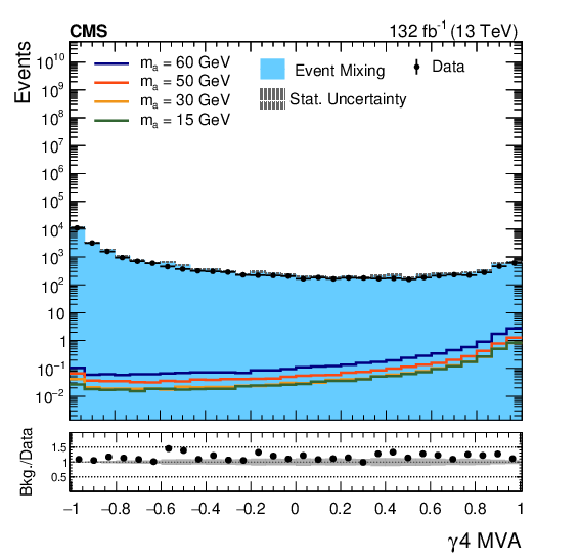
png pdf |
Figure 2-d:
Distribution of the photon identification BDT score of the fourth leading photon, $\gamma _{4}$. The events shown are selected from the ${m_{\gamma \gamma \gamma \gamma}}$ sidebands (110 $< {m_{\gamma \gamma \gamma \gamma}} < $ 115 GeV or 135 $ < {m_{\gamma \gamma \gamma \gamma}} < $ 180 GeV) for event mixing and data after fulfilling the selection criteria described in Section 4, while the signals are scaled with a cross-section of 1 pb. |
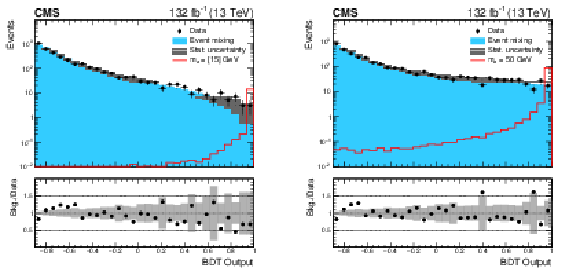
png pdf |
Figure 3:
Distribution of the BDT output for ${m_{a}} = $ 15 GeV (left) and 50 GeV (right) in data and simulated signal and event mixing (after smoothing) events. Events shown are selected after fulfilling the selection criteria described in Section 4 in the mass window 110 $ < {m_{\gamma \gamma \gamma \gamma}} < $ 180 GeV, while the signal is scaled with a cross-section of 1 pb. |
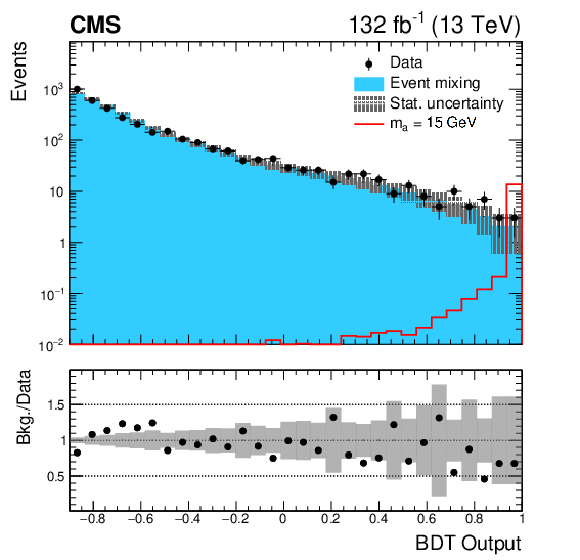
png pdf |
Figure 3-a:
Distribution of the BDT output for ${m_{a}} = $ 15 GeV in data and simulated signal and event mixing (after smoothing) events. Events shown are selected after fulfilling the selection criteria described in Section 4 in the mass window 110 $ < {m_{\gamma \gamma \gamma \gamma}} < $ 180 GeV, while the signal is scaled with a cross-section of 1 pb. |
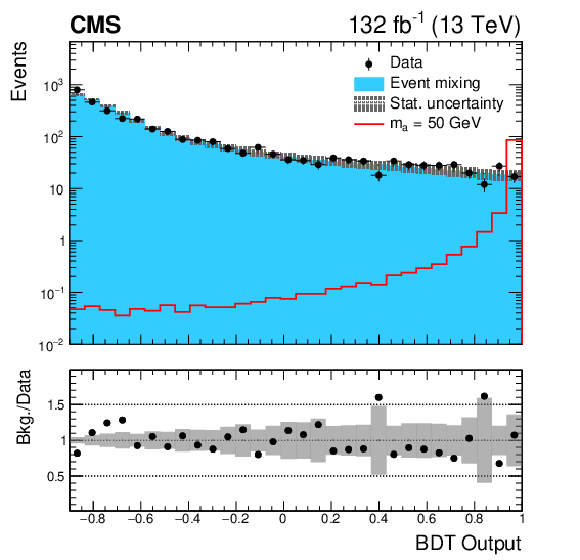
png pdf |
Figure 3-b:
Distribution of the BDT output for ${m_{a}} = $ 50 GeV in data and simulated signal and event mixing (after smoothing) events. Events shown are selected after fulfilling the selection criteria described in Section 4 in the mass window 110 $ < {m_{\gamma \gamma \gamma \gamma}} < $ 180 GeV, while the signal is scaled with a cross-section of 1 pb. |

png pdf |
Figure 4:
The parameterized signal shape for ${m_{a}} = $ 15 GeV is shown for the 2016 (upper left), 2017 (upper right), and 2018 (lower) data-taking years. Separate signal models are built for each of the three data-taking years, which are then scaled by the appropriate luminosity and summed in order to construct the final signal model. The open squares represent simulated events and the blue line is the corresponding model. Also shown is the $\sigma _{\text {eff}}$ value (half the width of the narrowest interval containing 68.3% of the invariant mass distribution), with the corresponding interval as a gray band and the FWHM, with the corresponding interval marked with a double arrow. |
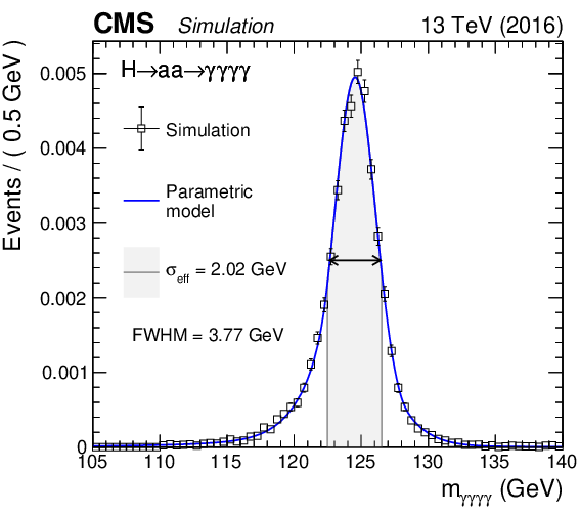
png pdf |
Figure 4-a:
The parameterized signal shape for ${m_{a}} = $ 15 GeV is shown for the 2016 data-taking year. A separate signal model is built, which is then scaled by the appropriate luminosity and summed in order to construct the final signal model. The open squares represent simulated events and the blue line is the corresponding model. Also shown is the $\sigma _{\text {eff}}$ value (half the width of the narrowest interval containing 68.3% of the invariant mass distribution), with the corresponding interval as a gray band and the FWHM, with the corresponding interval marked with a double arrow. |

png pdf |
Figure 4-b:
The parameterized signal shape for ${m_{a}} = $ 15 GeV is shown for the 2017 data-taking year. A separate signal model is built, which is then scaled by the appropriate luminosity and summed in order to construct the final signal model. The open squares represent simulated events and the blue line is the corresponding model. Also shown is the $\sigma _{\text {eff}}$ value (half the width of the narrowest interval containing 68.3% of the invariant mass distribution), with the corresponding interval as a gray band and the FWHM, with the corresponding interval marked with a double arrow. |

png pdf |
Figure 4-c:
The parameterized signal shape for ${m_{a}} = $ 15 GeV is shown for the 2018 data-taking year. A separate signal model is built, which is then scaled by the appropriate luminosity and summed in order to construct the final signal model. The open squares represent simulated events and the blue line is the corresponding model. Also shown is the $\sigma _{\text {eff}}$ value (half the width of the narrowest interval containing 68.3% of the invariant mass distribution), with the corresponding interval as a gray band and the FWHM, with the corresponding interval marked with a double arrow. |
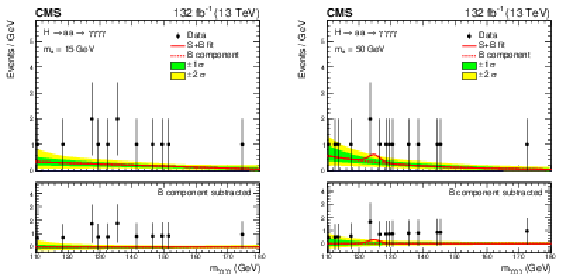
png pdf |
Figure 5:
The invariant mass distribution, ${m_{\gamma \gamma \gamma \gamma}}$, for data (black points) and the signal-plus-background model fit is shown for ${m_{a}} = $ 15 GeV (left) and ${m_{a}} = $ 50 GeV (right). The solid red line shows the total signal-plus-background contribution, whereas the dashed red line shows the background component only. The lower panel in each plot shows the residual signal yield after the background subtraction. The one (green) and two (yellow) standard deviation bands include the uncertainties in the background component of the fit. |

png pdf |
Figure 5-a:
The invariant mass distribution, ${m_{\gamma \gamma \gamma \gamma}}$, for data (black points) and the signal-plus-background model fit is shown for ${m_{a}} = $ 15 GeV. The solid red line shows the total signal-plus-background contribution, whereas the dashed red line shows the background component only. The lower panel in each plot shows the residual signal yield after the background subtraction. The one (green) and two (yellow) standard deviation bands include the uncertainties in the background component of the fit. |
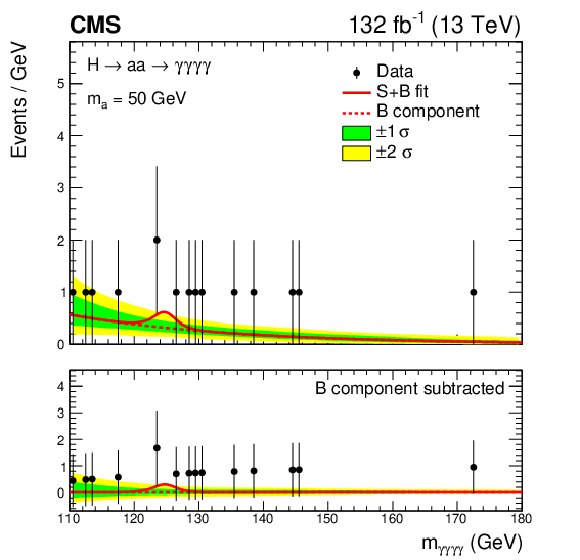
png pdf |
Figure 5-b:
The invariant mass distribution, ${m_{\gamma \gamma \gamma \gamma}}$, for data (black points) and the signal-plus-background model fit is shown for ${m_{a}} = $ 50 GeV. The solid red line shows the total signal-plus-background contribution, whereas the dashed red line shows the background component only. The lower panel in each plot shows the residual signal yield after the background subtraction. The one (green) and two (yellow) standard deviation bands include the uncertainties in the background component of the fit. |
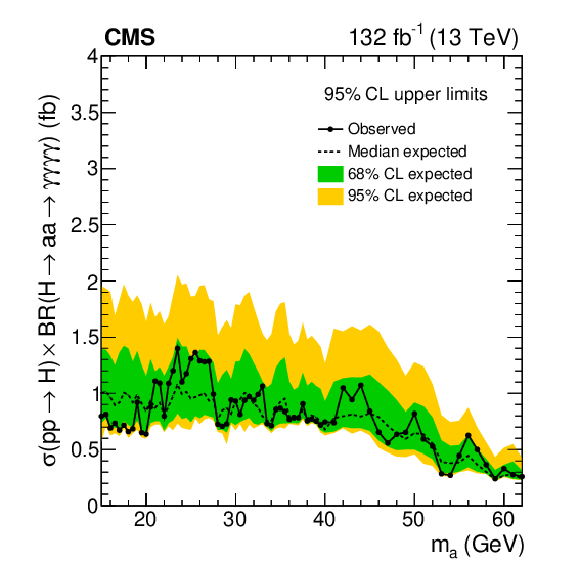
png pdf |
Figure 6:
Expected and observed 95% CL limits on the product of the production cross section of the Higgs boson and the branching fraction into four photons via a pair of pseuodscalars, $ {\sigma _{\mathrm{H}}}\, {\mathcal {B}({\mathrm{H} \to aa \to \gamma \gamma \gamma \gamma})} $, are shown as a function of ${m_{a}}$. The green (yellow) bands represent the 68% (95%) expected limit CL intervals. The fluctuation between individual points is due to the statistical limitation of the data sample and the result of individual BDT training networks utilized for each individual mass point scenario. |
| Tables | |
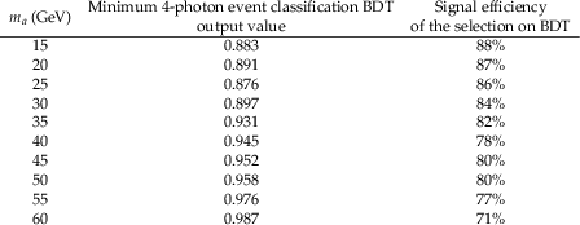
png pdf |
Table 1:
Summary of the optimized BDT output threshold values and the efficiency with respect to a selection on this output for each of the nominal signal hypothesis. |
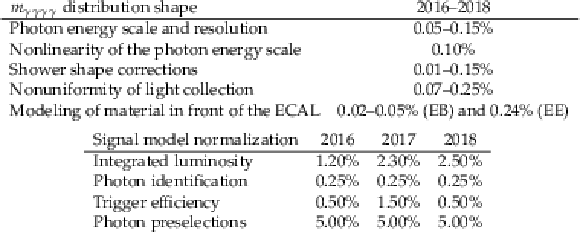
png pdf |
Table 2:
Summary of the systematic uncertainties considered in this analysis. |
| Summary |
| A search for a pair of light pseudoscalar bosons produced from the decay of the 125 GeV Higgs boson, which subsequently decay into photons, is presented. The analysis is based on proton-proton collision data collected at $\sqrt{s} = $ 13 TeV by the CMS experiment at the LHC in 2016, 2017, and 2018, which corresponds to a total integrated luminosity of 132 fb$^{-1}$. The analysis probes pseudoscalar bosons ranging in mass ($m_{a}$) from 15 to 62 GeV. No significant deviation from the background-only hypothesis is observed. Upper limits are set at 95% confidence level on the product of the production cross section of the Higgs boson and the branching fraction into four photons via a pair of pseuodscalars, ${{\sigma_{\mathrm{H}}}\,{\mathcal{B}({\mathrm{H} \to aa \to \gamma\gamma\gamma\gamma} )} }$. The observed (expected) limits range from 0.80 (1.00) fb for $m_{a} = $ 15 GeV to 0.26 (0.24) fb for $m_{a} = $ 62 GeV. |
| References | ||||
| 1 | ATLAS Collaboration | Observation of a new particle in the search for the standard model Higgs boson with the ATLAS detector at the LHC | PLB 716 (2012) 1 | 1207.7214 |
| 2 | CMS Collaboration | Observation of a new boson at a mass of 125 GeV with the CMS experiment at the LHC | PLB 716 (2012) 30 | CMS-HIG-12-028 1207.7235 |
| 3 | CMS Collaboration | Observation of a new boson with mass near 125 GeV in pp collisions at $ \sqrt{s} = $ 7 and 8 TeV | JHEP 06 (2013) 081 | CMS-HIG-12-036 1303.4571 |
| 4 | CMS Collaboration | Measurements of Higgs boson production cross sections and couplings in the diphoton decay channel at $ \sqrt{s}= $ 13 TeV | JHEP 07 (2021) 027 | CMS-HIG-19-015 2103.06956 |
| 5 | CMS Collaboration | Measurements of production cross sections of the Higgs boson in the four-lepton final state in proton-proton collisions at $ \sqrt{s}= $ 13 TeV | EPJC 81 (2021) 488 | CMS-HIG-19-001 2103.04956 |
| 6 | CMS Collaboration | Measurements of properties of the Higgs boson decaying into the four-lepton final state in pp collisions at $ \sqrt{s}= $ 13 TeV | EPJC 11 (2017) 047 | CMS-HIG-16-041 1706.09936 |
| 7 | CMS Collaboration | Measurement of the Higgs boson production rate in association with top quarks in final states with electrons, muons, and hadronically decaying tau leptons at $ \sqrt{s}= $ 13 TeV | EPJC 81 (2021) 378 | CMS-HIG-19-008 2011.03652 |
| 8 | CMS Collaboration | Measurements of $ \mathrm{t\bar{t}} $H production and the CP structure of the Yukawa interaction between the Higgs boson and the top quark in the diphoton decay channel | PRL 125 (2020) 061801 | CMS-HIG-19-013 2003.10866 |
| 9 | CMS Collaboration | Measurement of the inclusive and differential Higgs boson production cross sections in the leptonic WW decay mode at $ \sqrt{s}= $ 13 TeV | JHEP 03 (2021) 003 | CMS-HIG-19-002 2007.01984 |
| 10 | CMS Collaboration | A measurement of the Higgs boson mass in the diphoton decay channel | PLB 805 (2020) 135425 | CMS-HIG-19-004 2002.06398 |
| 11 | ATLAS Collaboration | Measurement of the Higgs boson mass in the $ H\rightarrow ZZ^* \rightarrow 4\ell $ and $ H \rightarrow \gamma\gamma $ channels with $ \sqrt{s}=$ 13 TeV pp collisions using the ATLAS detector | PLB 784 (2018) 345 | 1806.00242 |
| 12 | ATLAS Collaboration | Combined measurement of differential and total cross sections in the $ H \rightarrow \gamma \gamma $ and the $ H \rightarrow ZZ^* \rightarrow 4\ell $ decay channels at $ \sqrt{s} = $ 13 TeV with the ATLAS detector | PLB 786 (2018) 114 | 1805.10197 |
| 13 | ATLAS Collaboration | Measurement of the Higgs boson coupling properties in the $ H\rightarrow ZZ^{*} \rightarrow 4\ell $ decay channel at $ \sqrt{s} = $ 13 TeV with the ATLAS detector | JHEP 03 (2018) 095 | 1712.02304 |
| 14 | ATLAS and CMS Collaboration | Measurements of the Higgs boson production and decay rates and constraints on its couplings from a combined ATLAS and CMS analysis of the LHC pp collision data at $ \sqrt{s}= $ 7 and 8 TeV | JHEP 08 (2016) 045 | 1606.02266 |
| 15 | CMS Collaboration | Combined measurements of Higgs boson couplings in proton-proton collisions at $\sqrt{s} =$ 13 TeV | EPJC 79 (2019) 421 | CMS-HIG-17-031 1809.10733 |
| 16 | D. Curtin et al. | Exotic decays of the 125 GeV Higgs boson | PRD 90 (2014) 075004 | 1312.4992 |
| 17 | ATLAS Collaboration | Search for Higgs bosons decaying to $ aa $ in the $ \mu\mu\tau\tau $ final state in pp collisions at $ \sqrt{s} = $ 8 TeV with the ATLAS experiment | PRD 92 (2015) 052002 | 1505.01609 |
| 18 | CMS Collaboration | A search for pair production of new light bosons decaying into muons | PLB 752 (2016) 146 | CMS-HIG-13-010 1506.00424 |
| 19 | CMS Collaboration | Search for a very light NMSSM Higgs boson produced in decays of the 125 GeV scalar boson and decaying into $ \tau $ leptons in pp collisions at $ \sqrt{s}= $ 8 TeV | JHEP 01 (2016) 079 | CMS-HIG-14-019 1510.06534 |
| 20 | CMS Collaboration | Search for light bosons in decays of the 125 GeV Higgs boson in proton-proton collisions at $ \sqrt{s}= $ 8 TeV | JHEP 10 (2017) 076 | CMS-HIG-16-015 1701.02032 |
| 21 | ATLAS Collaboration | Search for the Higgs boson produced in association with a W boson and decaying to four b-quarks via two spin-zero particles in pp collisions at 13 TeV with the ATLAS detector | EPJC 76 (2016) 605 | 1606.08391 |
| 22 | ATLAS Collaboration | Search for Higgs boson decays to beyond-the-Standard-Model light bosons in four-lepton events with the ATLAS detector at $ \sqrt{s}= $ 13 TeV | JHEP 06 (2018) 166 | 1802.03388 |
| 23 | ATLAS Collaboration | Search for Higgs boson decays into pairs of light (pseudo)scalar particles in the $ \gamma\gamma $jj final state in pp collisions at $ \sqrt{s}= $ 13 TeV with the ATLAS detector | PLB 782 (2018) 750 | 1803.11145 |
| 24 | ATLAS Collaboration | Search for the Higgs boson produced in association with a vector boson and decaying into two spin-zero particles in the $ {\mathrm{H}} \rightarrow aa \rightarrow {4b} $ channel in pp collisions at $ \sqrt{s} = $ 13 TeV with the ATLAS detector | JHEP 10 (2018) 031 | 1806.07355 |
| 25 | ATLAS Collaboration | Search for Higgs boson decays into a pair of light bosons in the $ bb\mu\mu $ final state in pp collision at $ \sqrt{s} = $ 13 TeV with the ATLAS detector | PLB 790 (2019) 1 | 1807.00539 |
| 26 | CMS Collaboration | Search for an exotic decay of the Higgs boson to a pair of light pseudoscalars in the final state with two b quarks and two $ \tau $ leptons in proton-proton collisions at $ \sqrt{s}= $ 13 TeV | PLB 785 (2018) 462 | CMS-HIG-17-024 1805.10191 |
| 27 | CMS Collaboration | Search for an exotic decay of the Higgs boson to a pair of light pseudoscalars in the final state of two muons and two $ \tau $ leptons in proton-proton collisions at $ \sqrt{s}= $ 13 TeV | JHEP 11 (2018) 018 | CMS-HIG-17-029 1805.04865 |
| 28 | S. Chang, P. J. Fox, and N. Weiner | Visible Cascade Higgs Decays to Four Photons at Hadron Colliders | PRL 98 (2007) 111802 | hep-ph/0608310 |
| 29 | B. A. Dobrescu, G. L. Landsberg, and K. T. Matchev | Higgs boson decays to CP odd scalars at the Tevatron and beyond | PRD 63 (2001) 075003 | hep-ph/0005308 |
| 30 | F. Larios, G. Tavares-Velasco, and C. P. Yuan | Update on a very light CP odd scalar in the two Higgs doublet model | PRD 66 (2002) 075006 | hep-ph/0205204 |
| 31 | R. Dermisek and J. F. Gunion | The NMSSM Solution to the Fine-Tuning Problem, Precision Electroweak Constraints and the Largest LEP Higgs Event Excess | PRD 76 (2007) 095006 | 0705.4387 |
| 32 | ATLAS Collaboration | Search for new phenomena in events with at least three photons collected in pp collisions at $ \sqrt{s} = $ 8 TeV with the ATLAS detector | EPJC 76 (2016) 210 | 1509.05051 |
| 33 | CMS Collaboration | The CMS trigger system | JINST 12 (2017) P01020 | CMS-TRG-12-001 1609.02366 |
| 34 | CMS Collaboration | Performance of the CMS Level-1 trigger in proton-proton collisions at $ \sqrt{s} = $ 13 TeV | JINST 15 (2020) P10017 | CMS-TRG-17-001 2006.10165 |
| 35 | CMS Trigger, Data Acquisition Group Collaboration | The CMS high level trigger | EPJC 46 (2006) 605 | hep-ex/0512077 |
| 36 | CMS Collaboration | Particle-flow reconstruction and global event description with the CMS detector | JINST 12 (2017) P10003 | CMS-PRF-14-001 1706.04965 |
| 37 | CMS Collaboration | Electron and photon reconstruction and identification with the CMS experiment at the CERN LHC | JINST 16 (2021) P05014 | CMS-EGM-17-001 2012.06888 |
| 38 | CMS Collaboration | Performance of photon reconstruction and identification with the CMS detector in proton-proton collisions at $ \sqrt{s} = $ 8 TeV | JINST 10 (2015) P08010 | CMS-EGM-14-001 1502.02702 |
| 39 | CMS Collaboration | The CMS Experiment at the CERN LHC | JINST 3 (2008) S08004 | CMS-00-001 |
| 40 | CMS Collaboration | Precision luminosity measurement in proton-proton collisions at $ \sqrt{s}= $ 13 TeV in 2015 and 2016 | EPJC 81 (2021) 800 | CMS-LUM-17-003 2104.01927 |
| 41 | CMS Collaboration | CMS luminosity measurement for the 2017 Data-Taking period at $ \sqrt{s} = $ 13 TeV | CMS-PAS-LUM-17-004 | CMS-PAS-LUM-17-004 |
| 42 | CMS Collaboration | CMS luminosity measurement for the 2018 Data-Taking period at $ \sqrt{s} = $ 13 TeV | CMS-PAS-LUM-18-002 | CMS-PAS-LUM-18-002 |
| 43 | CMS Collaboration | Search for a standard model-like Higgs boson in the mass range between 70 and 110 GeV in the diphoton final state in proton-proton collisions at $ \sqrt{s}= $ 8 and 13 TeV | PLB 793 (2019) 320 | CMS-HIG-17-013 1811.08459 |
| 44 | R. F. J. Alwall et al. | The automated computation of tree-level and next-to-leading order differential cross sections, and their matching to parton shower simulations | JHEP07 79 (2014) | 1405.0301 |
| 45 | CMS Collaboration | Observation of the diphoton decay of the Higgs boson and measurement of its properties | EPJC 74 (2014) 3076 | CMS-HIG-13-001 1407.0558 |
| 46 | CMS Collaboration | Measurements of Higgs boson properties in the diphoton decay channel in proton-proton collisions at $ \sqrt{s}= $ 13 TeV | JHEP 11 (2018) 185 | CMS-HIG-16-040 1804.02716 |
| 47 | T. Sjostrand et al. | An introduction to PYTHIA 8.2 | CPC 191 (2015) 159 | 1410.3012 |
| 48 | CMS Collaboration | Event generator tunes obtained from underlying event and multiparton scattering measurements | EPJC 76 (2016) 155 | CMS-GEN-14-001 1512.00815 |
| 49 | CMS Collaboration | Extraction and validation of a new set of CMS PYTHIA8 tunes from underlying-event measurements | EPJC 80 (2020) 4 | CMS-GEN-17-001 1903.12179 |
| 50 | GEANT4 Collaboration | GEANT4 -- a simulation toolkit | NIMA 506 (2003) 250 | |
| 51 | M. Cacciari, G. P. Salam, and G. Soyez | The anti-$ {k_{\mathrm{T}}} $ jet clustering algorithm | JHEP 04 (2008) 063 | 0802.1189 |
| 52 | M. Cacciari, G. P. Salam, and G. Soyez | FastJet user manual | EPJC 72 (2012) 1896 | 1111.6097 |
| 53 | CMS Collaboration | Performance of missing transverse momentum reconstruction in proton-proton collisions at $ \sqrt{s} = $ 13 TeV using the CMS detector | JINST 14 (2019) P07004 | CMS-JME-17-001 1903.06078 |
| 54 | P. D. C. Manzano et al. | Hemisphere Mixing: a Fully Data-Driven Model of QCD Multijet Backgrounds for LHC Searches | 2017 European Physical Society Conference on High Energy Physics (EPS-HEP 2017) EPS-HEP2017 (2017) 370 | 1712.02538 |
| 55 | P. Baldi et al. | Parameterized neural networks for high-energy physics | EPJC 76 (2016) 235 | 1601.07913 |
| 56 | G. Cowan, K. Cranmer, E. Gross, and O. Vitells | Asymptotic formulae for likelihood-based tests of new physics | EPJC 11 (2011) 1554 | 1007.1727 |
| 57 | J. H. Friedman | SMART User's Guide | Stanford University Department of Statistics LCS_01 | |
| 58 | J. H. Friedman | A variable span scatterplot smoother | Stanford University Department of Statistics LCS_05 | |
| 59 | CMS Collaboration | Precise determination of the mass of the Higgs boson and tests of compatibility of its couplings with the standard model predictions using proton collisions at 7 and 8 TeV | EPJC 75 (2015), no. 5, 212 | CMS-HIG-14-009 1412.8662 |
| 60 | T. Skwarnicki | A study of the radiative CASCADE transitions between the Upsilon-Prime and Upsilon resonances | PhD thesis, Cracow, INP | |
| 61 | P. D. Dauncey, M. Kenzie, N. Wardle, and G. J. Davies | Handling uncertainties in background shapes: the discrete profiling method | JINST 10 (2015) P04015 | 1408.6865 |
| 62 | R. A. Fisher | On the Interpretation of $ \chi^{2} $ from Contingency Tables, and the Calculation of p | J. Royal Stat. Soc 85 (1922) 87 | |
| 63 | CMS Collaboration | Measurement of the inclusive $ W $ and $ Z $ production cross sections in pp collisions at $ \sqrt{s}= $ 7 TeV | JHEP 10 (2011) 132 | CMS-EWK-10-005 1107.4789 |
| 64 | CMS Collaboration | Combined results of searches for the standard model higgs boson in pp collisions at $ \sqrt{s}= $ 7 TeV | PLB 26 (2012) 710 | CMS-HIG-11-032 1202.1488 |
| 65 | LHC Higgs Cross Section Working Group | Handbook of LHC Higgs cross sections: 4. deciphering the nature of the Higgs sector | CERN (2016) | 1610.07922 |
| 66 | CMS Collaboration | HEPData record for this analysis | link | |

|
Compact Muon Solenoid LHC, CERN |

|

|

|

|

|

|